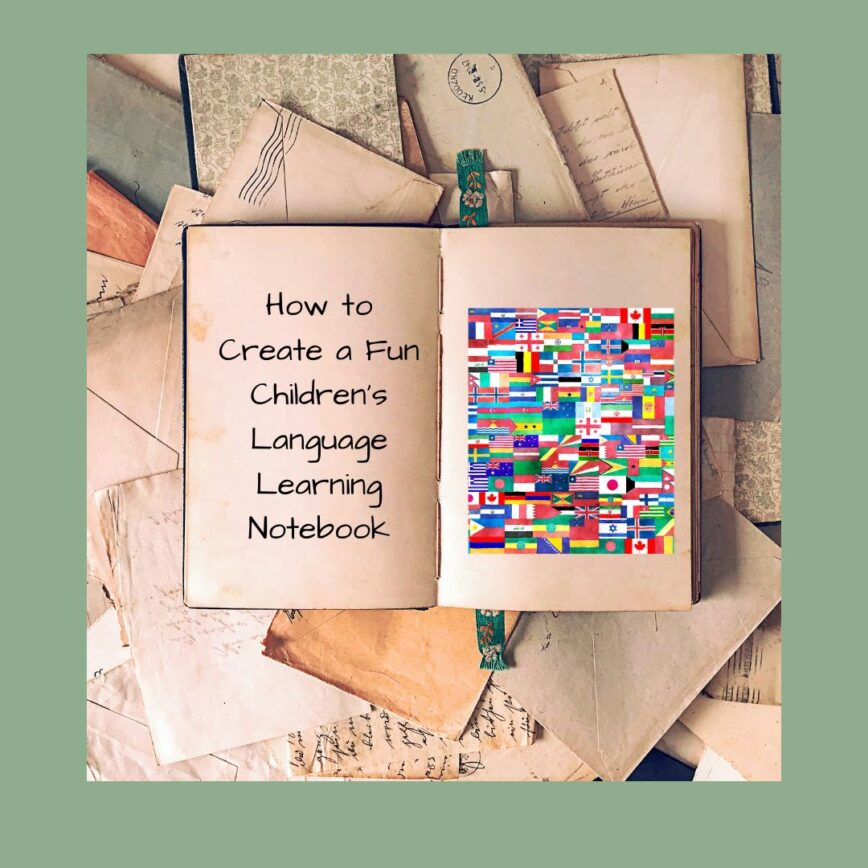
Introduction
Welcome, language learning enthusiasts and parents! In this blog post, we’re going to explore a creative and fun way for children to combine a language learning notebook with the wonders of nature journaling to ensure motivation whilst learning a new language in your home or homeschooling routines.
This approach not only enhances language skills but also nurtures a love for the great outdoors and curiosity about the world around us,which if you have been following me for a while, you know I am completely onboard with!
Materials Needed:
This blog post contains affiliate links from Amazon . If you use them, I might be rewarded credit or a commission of the sale (at no extra cost to you). Please note that I only recommend items that I personally use and love and I always have my readers’ best interest at heart.
Notebook
So you need to choose something durable and age-appropriate. This is not an easy task in itself. I would definitely consider a hardcover notebook with maybe the option of being able to decorate the cover.
We chose a filofax A5 notebook. Now I know you may be thinking that is a little expensive for my child, however if you look at the flexibility of the notebook and how easy it is to add pages or take them out without the whole book falling apart then I am going with the Filofax notebooks all the way!
Take a look at this video below in order to see the flexibility! Here are also some links to our favourite. We Went with the A5 version as it is easy to carry around and put in bags etc whilst out and about.
What makes Filofax notebooks so versatile?
You can also cut paper that you have at home in various colours etc and just by using this holepunch you can add the paper to your Filofax notebooks.
Art Supplies
Gather coloured pencils, markers, crayons, rubber, and stickers to add a touch of creativity to the language learning journey.
Plus lots of pencils. We do all our writing in pencil.
Language Learning Resources
Before you get really stuck in have you done the exercise together about choosing your language, why you are learning it, how you are going to learn it, where you are going to learn it and when you are going to start.
If not, here is a freebie for you to print out in order to ensure a fabulous start to your language learning.
So after you have gone through this process which other resources are you going to be using?
Nature Journal Supplies
Include a set of watercolor pencils, a small watercolor palette, a brush, and a small container for water for the nature journaling component.
So let’s get down to the ‘nitty gritty’
Setting Up the Language Learning Notebook
First Page / Cover
I want my child to love this language learning notebook so I always ask my daughter to draw a picture for the front of her notebook in order for her to be extremely motivtaed. As we are learning english as our second language she chose a union jack and her version of Big Ben

Sections of your Language Learning Notebook
This is where both you and your child can get creative. Which sections are you going to use for your notebook?
We are using
Vocabulary sections
Where we also draw the words forunderstanding and also print out flashcards etc. You can also divide this section into themes, such as Nature, Everyday words, The home etc.
Grammar Sections –
I would recommend to only use this section for older children 11 plus who really start getting into the depths of language learning. The first few years should be learnt through listening and speaking rather than writing and reading.
Pony Language Learning Adventures
We are using this section of my pony-mad daughters language notebook combining it with my blog post series. You could add a section that is specific to their hobby, as this also encourages motivation.
If you want to joing us on our Pony Language Learning Adventures then check out tis part of the blog.
Read – Aloud / Movie Tracker
Listening to a language can be frustrating at first but using stories that your child knows, bilingual books or popular films can be a great help.
Here are two trackers to print out and glue into your notebooks one for Books and one for Films so that yu can track what has been read or watched.
If you are really creative have a look at this pinerest board to get more ideas for various trackers.
Nature Journaling Section
As you all know I am a huge advocate of learning languages through nature and the great outdoors. Just start really basic and go outside in the forest and part and get your child to draw a tree or a scenery and see which words thwy know in both their negative and new foreign language. Children tend to retain more information in a fun way of learning rather than basic classroom activities.
If you are what I call advanced nature journalists as a family and are maybe using the Exploring Nature With Children curriculum – take a look here. You could choose one topic per month where you look at this in your learning language of choice and see how your language learning activities blossom.
Conclusion
By creating a language learning notebook with a nature journal, you’ve created an immersive and dynamic language learning experience for children. This approach not only facilitates language development but also instils a sense of curiosity and appreciation for the natural world. So, grab your notebooks, set them up, head outdoors, and let the language learning adventure begin!


